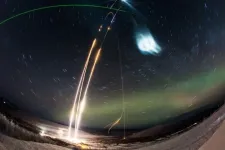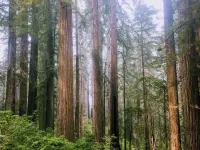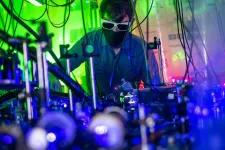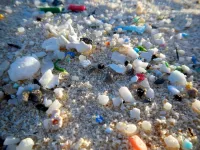(Press-News.org) Results of a 2018 multirocket launch at Poker Flat Research Range north of Fairbanks, Alaska, will help scientists better understand the impact of more water vapor accumulating near the fringe of the Earth's atmosphere.
"This is the first time anyone has experimentally demonstrated that cloud formation in the mesosphere is directly linked to cooling by water vapor itself," said Irfan Azeem, space physicist at Astra LLC in Louisville, Colorado, and principal investigator of the Super Soaker mission.
The NASA-funded project, named Super Soaker, involved launching a canister containing about 50 gallons of water skyward to create an artificial polar mesospheric cloud on the night of Jan. 25-26, 2018. A ground-based laser radar (lidar) detected the cloud that formed 18 seconds after the water release 50 miles overhead.
A time-lapse photograph captures the Super Soaker launches on Jan. 25-26, 2018. Three rockets launched with the mission, two using vapor tracers to track wind movement and one releasing a water canister to seed a polar mesospheric cloud. The green laser beam visible at the top left is the LIDAR beam used to measure the artificial cloud.
Findings of the Super Soaker experiment were published this month in the Journal of Geophysical Research in a paper authored by Richard Collins, director of the University of Alaska Fairbanks Graduate School and a professor of atmospheric sciences at the Geophysical Institute, with Azeem and a team of scientists from across the United States. Geophysical Institute graduate students Jintai Li and Jennifer Alspach, who developed lidar systems for the project and participated in the experiment, were among the paper's 10 co-authors. Undergraduate student Mikayla Grunin worked with Li to develop one of the lidar systems.
The Super Soaker experiment showed that water vapor contributes to cloud formation in the upper atmosphere in two ways: by making the air more humid and by cooling the air. This moisture-driven cooling is distinct from the "greenhouse effect" warming that water vapor causes in the lowest level of the atmosphere -- the troposphere.
Increased water vapor comes from methane, which is being produced by humans in rising quantities. Methane rises into the mesosphere, where it oxidizes in sunlight to form water vapor and carbon dioxide.
Space traffic also adds to the amount of water vapor collecting in this region of the atmosphere, as water vapor is common in rocket engine exhaust, the paper notes. Increases in space traffic will result in more water being deposited in the upper atmosphere.
What are the implications of this cooling of the upper atmosphere?
"We expect that a more humid atmosphere should be cloudier, just as we see fog form over ponds on cold mornings. What we found that is new is that the water vapor appears to actively cool the atmosphere to promote cloud formation," Collins said.
"We don't believe it's going to cause a radical effect at the ground, but it helps us understand long-term climate trends in the atmosphere and the role of water vapor in the climate system," he said. "And it also allows us to understand better our weather and climate models, where a lot of times cloud formation is the acid test of whether all the parts of your weather and climate model are working."
Polar mesospheric clouds exist at the edge of space at an altitude of 47 to 53 miles. Water vapor at these altitudes freezes into ice crystals, forming the clouds. These clouds can be seen as they glow brightly after sunset when they are lit from below by sunlight against a dark sky. Polar mesospheric clouds are also called night-glowing or noctilucent clouds.
The clouds appear naturally in the Arctic or Antarctic during summer. Researchers chose to create the artificial cloud in the winter to have a controlled setting.
These clouds have long been used as indicators of climate change. First reported in the late 1800s, the clouds have been seen more often in the 20th and 21st centuries.
The Super Soaker experiment consisted of three rocket launches from Poker Flat Research Range within about 40 minutes.
The first two rockets dispersed trimethyl aluminum, which, when it reacts with oxygen, produces the harmless products of aluminum oxide, carbon dioxide and water vapor, as well as a bluish white glow. By tracking this glow, researchers can determine the winds over a wide range of altitudes, letting them see the weather conditions into which the water was released.
The third rocket, launched 90 seconds after the second rocket, carried the water canister. The canister was detonated at an altitude of 53 miles to create a small polar mesospheric cloud that was detectable only by the lidar.
Researchers are eager to conduct a second Super Soaker, one that will eject much more water.
"What we saw was very, very fine, and we'd like to get more water up there to get a thicker cloud and see if we can directly measure the cooling effect rather than inferring it from the fact that the cloud formed," Collins said, referring to data acquired from the ground-based lidar.
INFORMATION:
Other co-authors of the paper represented the Space Science Division at the Naval Research Laboratory in Washington, D.C.; Astra LLC of Boulder, Colorado; the Department of Physics, Center for Atmospheric and Space Sciences at Utah State University; the Department of Physics at Clemson University; GATS Inc. of Boulder, Colorado; and the Applied Physics Laboratory at Johns Hopkins University.
Poker Flat Research Range is owned by the UAF Geophysical Institute and is operated under a contract with NASA's Wallops Flight Facility, which is part of the Goddard Space Flight Center.
In recent years, European forests have suffered greatly from extreme climate conditions and their impacts. More than half of Europe's forests are potentially at risk from windthrow, forest fire, insect attacks or a combination of these. This is the main result of a study by an international team of scientists with the participation of Henrik Hartmann from the Max Planck Institute for Biogeochemistry in Jena, Germany. Using satellite data and artificial intelligence, the scientists studied vulnerability to disturbances in the period between 1979 and 2018. In the light of ongoing climate change, their findings are very important for improving mitigation and adaptation strategies ...
Materials called perovskites can be more readily incorporated into silicon-based semiconducting platforms by using a microfluidic pumping technology developed at KAUST.
The perovskites currently being explored for many applications in new technologies are diverse materials sharing the same crystalline structure as the natural mineral perovskite. These semiconducting materials show great promise in a variety of optoelectronic applications, such as light emitters, sensors and solar cells.
Compared to traditional semiconductors, perovskites are soft and unstable. "This makes it difficult to pattern them using standard lithography methods," says materials scientist Iman Roqan at KAUST.
The challenge tackled by Roqan and her colleagues was to adapt microfluidic technologies to manipulate ...
COLUMBUS, Ohio - Parents may fear that if their high school student isn't motivated to do well in classes, there's nothing that will change that.
But a new study that followed more than 1,600 students over two years found that students' academic motivation often did change - and usually for the better.
Results showed that increasing students' sense of "belongingness" in school was one key way of increasing academic motivation.
"Our results point to a more hopeful picture for students who start out with lower levels of motivation - they tend to shift toward more adaptive ...
March 1, 2021 - A new paper published online in the Annals of the American Thoracic Society discusses how smoking may affect risk for COVID-19 and the types of research that are needed to better understand the link between smoking and COVID-19 risk.
In "Smoking and COVID-19: The Real Deal," Enid Neptune, MD, and Michelle N. Eakin, PhD, of the Division of Pulmonary and Critical Care Medicine, Johns Hopkins University, discuss research to date on this topic and propose areas of research that can help clarify this relationship.
Studies have shown that current smokers with COVID-19 have twice the ...
New research has determined the prevalence of private security systems may be robbing the general public of the police services they need.
Dr. Ross Hickey is an economist in UBC Okanagan's Faculty of Management and the Irving K. Barber Faculty of Arts and Social Sciences. Along with a team of researchers, Hickey examined data from a social survey of Canada victimization, where people answered whether they had added security measures to their homes to protect themselves from crime.
"We are seeing more expenditures on private security systems installed in homes and, as economists, we have to ask why. We know that crime rates are down and expenditure on police is up," says Hickey. "But private security purchases are at an all-time ...
CORVALLIS, Ore. - Selectively cutting trees in riparian zones to aid forest restoration can be done without adversely affecting streams' water temperature as long as the thinning isn't too intensive, new research by Oregon State University shows.
Published in PLOS One, the study led by OSU College of Agricultural Sciences graduate student David Roon is one of the few to quantify restorative thinning's effects on forest streams.
"We don't know much about what happens with the more subtle changes in shade and light that come with thinning," Roon said. "Most of the research so far has looked at the effects of clearcutting with no stream-side buffer at all, or harvests outside of an untouched buffer area. And regulatory requirements ...
Around 2.5 billion years ago, our planet experienced what was possibly the greatest change in its history: According to the geological record, molecular oxygen suddenly went from nonexistent to becoming freely available everywhere. Evidence for the "great oxygenation event" (GOE) is clearly visible, for example, in banded iron formations containing oxidized iron. The GOE, of course, is what allowed oxygen-using organisms - respirators - and ultimately ourselves, to evolve. But was it indeed a "great event" in the sense that the change was radical and sudden, or were the organisms alive at the time already using free oxygen, just at lower levels?
Prof. Dan Tawfik of the Weizmann Institute of Science's Biomolecular Sciences Department explains that the dating of the GOE ...
HOUSTON - (March 1, 2021) - Rice University physicists have discovered a way to trap the world's coldest plasma in a magnetic bottle, a technological achievement that could advance research into clean energy, space weather and astrophysics.
"To understand how the solar wind interacts with the Earth, or to generate clean energy from nuclear fusion, one has to understand how plasma -- a soup of electrons and ions -- behaves in a magnetic field," said Rice Dean of Natural Sciences Tom Killian, the corresponding author of a published study about the work in Physical Review Letters.
Using laser-cooled strontium, ...
Europeans spend more than £700 billion (€800bn) a year on recreational visits to water bodies - but perceived poor water quality costs almost £90 billion (€100bn) in lost visits, a new study has found.
The new research - led by a European collaboration involving the University of Exeter and the University of Stirling - used data from 11,000 visits in 14 different countries to analyse the economic value of water bodies, such as rivers, lakes, waterfalls, beaches and seaside promenades.
The research team estimated that people spend an average of £35 (€40) travelling to and from these sites, with a typical family making 45 such trips each year.
The team also found ...
Rutgers scientists for the first time have pinpointed the sizes of microplastics from a highly urbanized estuarine and coastal system with numerous sources of fresh water, including the Hudson River and Raritan River.
Their study of tiny pieces of plastic in the Hudson-Raritan Estuary in New Jersey and New York indicates that stormwater could be an important source of the plastic pollution that plagues oceans, bays, rivers and other waters and threatens aquatic and other life.
"Stormwater, an understudied pathway for microplastics to enter waterways, had similar or higher concentrations of ...




